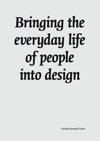Bringing the everyday life of people into design
Summary
Products play a role in our everyday lives. Insight into the experiences of people in their everyday lives is of great use for designing products. For example, the contexts in which products are used (physical, social, culture etc.) and the state (excited, tired, concentrated etc.) of the users influence how they experience using products. However, in design practice using this type of diverse, subjective and multi-layered information, as inspirational input for the design process, is a recent development.
In this research project, I explored how this information can be communicated in such a way that it supports designers (1) to empathise with users, (2) to be inspired to create new product ideas, and (3) to be engaged to use this information in their design processes.
By a set of eight explorative studies in collaboration with industrial practice (varying from a small design firm to a multinational telecom company) the current situation in design practice is investigated, tools to communicate this type of information are designed and explored in use, and a theoretical framework is created to organise the elements which play a role in this communication.
The filled in framework and a set of guidelines for practitioners to successfully communicate rich experience information in design are the results. The framework folds out how the three main qualities (empathy, inspiration and engagement) can be achieved by setting in mechanisms and means. The guidelines show various examples of how these qualities can be supported.
(via InfoDesign)





[…] Putting people first » Bringing the everyday life of people into designProducts play a role in our everyday lives. Insight into the experiences of people in their everyday lives is of great use for designing products. For example, the contexts in which products are used (physical, social, culture etc.) and the state (excited, tired, concentrated etc.) of the users influence how they experience using products. However, in design practice using this type of diverse, subjective and multi-layered information, as inspirational input for the design process, is a recent development. […]